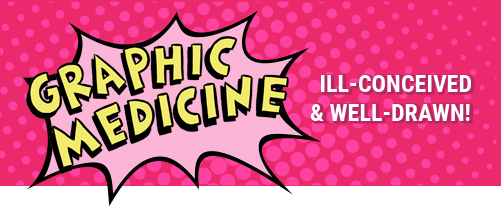Class 7: Comics-Making Project
Introduction:
Reading and discussing comics is one way to gain understanding of the health care system and the experience of illness from multiple perspectives. Another (and complementary) way is to have students tell their own stories. Using the comics medium as a means of self-reflection and creative expression, students write and draw a brief comic about an important personal experience related to health and medicine. For teaching medical students, the focus should be on a formative experience that tells something about their medical education, with an emphasis on their professional identity. For other students, the assignment can be more general, telling a story related to health, illness, and the medical profession.
In the Graphic Storytelling course at Penn State College of Medicine, the comics-making project is a longitudinal assignment that begins with the first class and is due on the last. Each class session devotes 30–40 minutes to discussing the project, focusing on the challenges students are encountering, and brainstorming solutions as a group. Alternatively, instructors can condense the assignment into a single class, assigning the project as homework in the first class, and devoting the last class to discussion and critique of the projects.
The final project-based activity for this module is for students to develop a graphic narrative about a meaningful health care experience. The story can be based on a personal experience as a patient, that of a family member, or something related to one’s professional education or clinical activities (if relevant). Whether the project starts during the first class or the last, My Graphic Story Project provides an overview, guidelines, supplies, and expectations to help guide students’ in developing and producing their own comics. This is a challenging assignment. Suggested readings for helping students get started are listed under Class Resources below.
Class Resources
- Abel, Jessica and Matt Madden. Drawing Words and Writing Pictures: A Definitive Course from Concept to Comic in 15 Lessons. New York, NY: First Second, 2008.
- McCloud, Scott. Making Comics: Storytelling Secrets of Comics, Manga and Graphic Novels. New York, NY: William Morrow Paperbacks, 2006.
- Eisner, Will. Graphic Storytelling and Visual Narrative. New York, NY: W. W. Norton & Company, 2008.
- Brunetti, Ivan. Cartooning Philosophy and Practice. New Haven, CT: Yale University Press, 2011.
- Chapman, Robyn. Drawing Comics Lab: 52 Exercises on Characters, Panels, Storytelling, Publishing & Professional Practices. Beverly, MA: Quarry Books, 2012.
- Barry, Lynda. Syllabus: Notes from an Accidental Professor. Quebec, Montreal: Drawn & Quarterly Publications, 2014.
- Storyshots. Tumblr post. 2012. http://storyshots.tumblr.com/post/25032057278/22-storybasics-ive-picked-up-in-my-time-at-pixar.
- “Seven Elements of Good Storytelling.” https://msu.edu/course/tc/842/SevenElements%20Story.htm
- My Graphic Story Project (PDF)
Discussion Questions
- For your own graphic story, how did you go about selecting a memorable or important health/medical experiences? What were the criteria you used to select it?
- In developing the story in comic format, what did you do and why did you take this approach?
- What challenges did you face, and how did you resolve them to accomplish your vision?
- How does your comic inform the importance of self-reflection and understanding of different perspectives?
- What questions do you have for the other comic authors?






